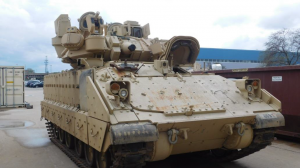The U.S. military is planning to add active defenses that attempt to shoot down incoming missiles and shells with computer targeted and fired bullets into its armored vehicles. Apparently, the technology, now proven by the Israeli military and trial by U.S. defense contractors, has finally reached a point at which it is "ready for prime time." The system also includes a "soft kill" system (e.g. jamming or confusing guidance systems in guided munitions). Some of the technology is illustrated in a Lockheed set of infographics focusing on the "soft kill" aspect and noting that: "In a series of live-fire tests conducted by the U.S. Army, MAPS-enabled systems defeated 15 out of 15 anti-tank guided missiles by jamming their signals, causing them to fly off-target." It still isn't clear, however, just how effective these systems are in realistic conditions, or what their limitations are.
The Army will soon start testing a Lockheed Martin anti-missile defense system designed to work with the service's M1 tanks and Bradley and Stryker armored vehicles.Under a three-year agreement announced Tuesday, Lockheed will provide its Modular Active Protection System, or MAPS, base kit, which includes a framework of vehicle sensors and countermeasures designed to detect, track and destroy rocket-propelled grenades and anti-tank guided missiles, according to a company news release. . . .Lockheed began working with the Army to develop its MAPS technology in 2014.Advertisement"Since then, the MAPS base kit has proven itself in multiple live-fire demonstrations," said David Rohall, program manager for Advanced Ground Vehicle Systems at Lockheed Martin. "We're ready to support integration and testing on a variety of Army combat vehicles, the final step before the Army makes a formal decision on fielding this capability."The service has been searching for an active protection system for more than 10 years. It selected the Quick Kill APS, made by Raytheon Co., to equip its manned ground vehicles under the Future Combat Systems program. The effort died, however, when then-Defense Secretary Robert Gates canceled FCS in 2009 -- the same year the Israel Defense Forces fielded the first Trophy APS systems.The Army launched an accelerated effort in early 2017 to equip its M1 tanks, Bradley fighting vehicles and Strykers with commercially available active protection devices such as the Trophy system. The Army agreed to equip four brigade combat teams' worth of M1 tanks with the Trophy system and has tested the Israeli APS system, known as Iron Fist, to protect the Bradley.Equipping the lightly armored Stryker with APS has proven more challenging, Army officials told Congress in March. The APS systems the Army tested could defeat an incoming missile, but it was difficult to prevent the secondary effects of the destroyed enemy rocket from penetrating the vehicle. . . .The contract also covers developing the base kit for vehicle protection capabilities beyond active protection, such as underbelly blast protection, according to the release.
According to another source:
The Army is exploring a plethora of anti-missile defenses for its armored vehicles. Many Abrams tanks already have the Rafael Trophy, a battle-tested Israeli countermeasure which physically shoots down incoming anti-tank rockets and missiles. The Army has also been working to integrate another off-the-shelf Israeli active protection system, Elbit’s Iron Fist, onto the M2 Bradley, albeit with mixed success and delays. Bradley’s a smaller vehicle than Abrams with less room and electrical power to add radar-controlled interceptors. And the service is trying out two slimmed-down systems, one by Rafael and one by Germany’s Rheinmetall, on the Stryker. As the lightest of the vehicles in question, it has proven the hardest to protect.

Iron Fist-Active Protection System Installed On A U.S. Army M2 Bradley Infantry Fighting Vehicle (Rada photo).
So the Army has plenty of irons in the fire – but that’s part of the problem. Each of these active protection systems takes a different approach to intercepting enemy anti-tank weapons. Each uses a different mix of radar and other sensors to detect the threat, different “hard-kill” interceptors and “soft-kill” jammers & decoys to defeat it, and different computer hardware and software to control it all. Each of them requires different training and tools to install, operate and maintain.
See also here.
No comments:
Post a Comment